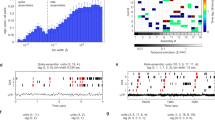Abstract
We present a neural model for the organization and neural dynamics of the medial pallium, the toad's homolog of mammalian hippocampus. A neural mechanism, called cumulative shrinking, is proposed for mapping temporal responses from the anterior thalamus into a form of population coding referenced by spatial positions. Synaptic plasticity is modeled as an interaction of two dynamic processes which simulates acquisition and both short-term and long-term forgetting. The structure of the medial pallium model plus the plasticity model allows us to provide an account of the neural mechanisms of habituation and dishabituation. Computer simulations demonstrate a remarkable match between the model performance and the original experimental data on which the dishabituation hierarchy was based. A set of model predictions is presented, concerning mechanisms of habituation and cellular organization of the medial pallium
Similar content being viewed by others
References
Arbib MA (1991) Neural mechanisms of visuomotor coordination: the evolution of rana computatrix. In: Arbib MA, Ewert J-P (eds) Visual structures and integrated functions. Research notes in neural computing. Springer, Berlin Heidelberg New York, pp 3–30
Bailey CH, Chen MC (1983) Morphological basis of long-term habituation and sensitization in Aplysia. Science 220:91–93
Castellucci VF, Carew TJ, Kandel ER (1978) Cellular analysis of long-term habituation of the gill-withdrawal reflex of Aplysia California. Science 202:1306–1308
Cervantes-Pérez F, Guevara-Pozas AD, Herrera-Becerra AA (1991) Modulation of prey-catching behavior in toads: Data and modeling. In: Arbib MA, Ewert J-P (eds) Visual structures and integrated functions. Research notes in neural computing. Springer, Berlin Heidelberg New York, pp 397–416
Eikmanns KH (1955) Verhaltensphysiologische Untersuchungen über den Beutefang und das Bewegungssehen der Erdkröte (Bufo bufo L). Z Tierpsychol 12:229–253
Ewert J-P (1984) Tectal mechanisms that underlie prey-catching and avoidance behaviors in toads. In: Vanegas H (eds) Comparative neurology of the optic tectum. Plenum, New York, pp 246–416
Ewert J-P (1987) Neuroethology: toward a functional analysis of stimulus-response mediating and modulating neural circuitries. In: Ellen P, Thinus-Blonc C (eds) Cognitive processes and spatial orientation in animal and man, pt. 1. Martinus Nijhoff, Dordrecht, pp 177–200
Ewert J-P, Ingle D (1971) Excitatory effects following habituation of prey-catching activity in frogs and toads. J Comp Physiol Psychol 77:369–374
Ewert J-P, Kehl W (1978) Configurational prey-selection by individual experience in the toad Bufo bufo. J Comp Physiol A 126:105–114
Finkenstädt T (1989a) Stimulus-specific habituation in toads: 2DG studies and lesion experiments. In: Ewert J-P, Arbib MA (eds) Visuomotor coordination: amphibians, comparisons, models, and robots. Plenum, New York, pp 767–797
Finkenstadt T (1989b) Visual associative learning: searching for behaviorally relevant brain structures in toads. In: Ewert J-P, Arbib MA (eds) Visuomotor coordination: amphibians, comparisons, models, and robots. Plenum, New York, pp 799–832
Finkenstädt T, Ewert J-P (1988a) Stimulus-specific long-term habituation of visually guided orienting behavior toward prey in toads: a 14C-2DG study. J Comp Physiol A 163: 1–11
Finkenstadt T, Ewert J-P (1988b) Effects of visual associative conditioning on behavior and cerebral metabolic activity in toads. Naturwissenschaften 75:85–87
Gluck MA, Thompson RF (1987) Modeling the neural substrates of associative learning and memory: A computational approach. Phychol Rev 94:1–16
Grossberg S (1976) Adaptive pattern classification and universal recoding: I. Parallel development and coding of neural feature detectors. Biol Cybern 23:121–134
Grossberg S, Kuperstein M (1986) Neural dynamics of adaptive sensory-motor control. North-Holland, Amsterdam
Groves PM, Thompson RF (1970) Habituation: a dual-process theory. Psychol Rev 77:419–450
Herrick CJ (1933) The amphibian forebrain. VIII. Cerebral hemispheres and pallial primordia. J Comp Neurol 58:737–759
Hoffman HH (1963) The olfactory bulb, accessory olfactory bulb and hemisphere of some anurans. J Comp Neurol 120:317–368
Kandel ER (1976) Cellular basis of behavior: An introduction to behavioral neurobiology. Freeman, New York
Kicliter E, Ebbesson SOE (1976) Organization of the “nonolfactory” telencephalon. In Llinás R, Precht W (eds) Frog neurobiology. Springer, Berlin Heidelberg New York, pp 946–972
Lara R, Arbib MA (1985) A model of the neural mechanisms responsible for pattern recognition and stimulus specific habituation in toads. Biol Cybern 51:223–237
Sokolov EN (1960) Neuronal models and the orienting reflex. In: Brazier MAB (eds) The central nervous system and behavior: III. Macy Foundation, New York, pp 187–276
Thompson RF (1986) The neurobiology of learning and memory. Science 233:941–947
Wang DL, Arbib MA (1991a) How does the toad's visual system discriminate different worm-like stimuli? Biol Cybern 64:251–261
Wang DL, Arbib MA (1991b) Hierarchical dishabituation of visual discrimination in toads. In: Meyer J-A, Wilson S (eds) Simulation of adaptive behavior: From animals to animals. MIT Press, Cambridge, pp 77–88
Wang DL, Ewert J-P (1992) Configurational pattern discrimination responsible for dishabituation in common toads Bufo bufo (L). Behavioral tests of the predictions of a neural model. J Comp Physiol A 170:317–325
Wang DL, Hsu CC (1988) A neuron model for computer simulation f neural networks. Acta Automatica Sinica 14:424–430
Wang DL, Hsu CC (1990) SLONN: A simulation language for modeling of neural networks. Simulation 55:69–83
Wang DL, King IK (1988) Three neural models which process temporal information. In Proc 1st Annu Conf Intern Neur Netw Soc. Boston, MA, pp 227
Author information
Authors and Affiliations
Additional information
The research described in this paper was supported in part by grant no. 1RO1 NS 24926 from the National Institutes of Health (M.A.A., Principal Investigator)
About this article
Cite this article
Wang, D., Arbib, M.A. Modeling the dishabituation hierarchy: The role of the primordial hippocampus. Biol. Cybern. 67, 535–544 (1992). https://doi.org/10.1007/BF00198760
Received:
Accepted:
Issue Date:
DOI: https://doi.org/10.1007/BF00198760




